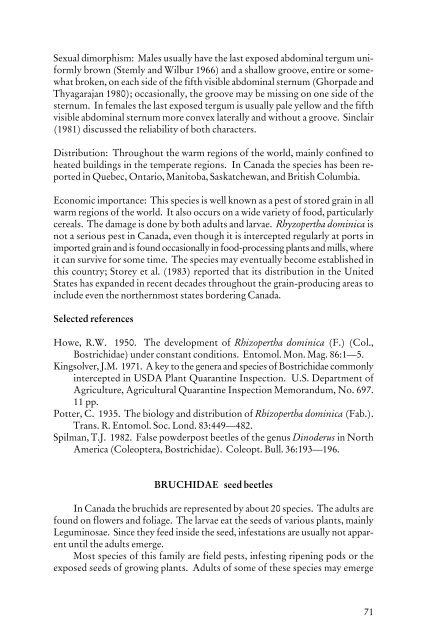Beetles Identification Guide
Beetles Identification Guide
Beetles Identification Guide
You also want an ePaper? Increase the reach of your titles
YUMPU automatically turns print PDFs into web optimized ePapers that Google loves.
Sexual dimorphism: Males usually have the last exposed abdominal tergum uniformly<br />
brown (Stemly and Wilbur 1966) and a shallow groove, entire or somewhat<br />
broken, on each side of the fifth visible abdominal sternum (Ghorpade and<br />
Thyagarajan 1980); occasionally, the groove may be missing on one side of the<br />
sternum. In females the last exposed tergum is usually pale yellow and the fifth<br />
visible abdominal sternum more convex laterally and without a groove. Sinclair<br />
(1981) discussed the reliability of both characters.<br />
Distribution: Throughout the warm regions of the world, mainly confined to<br />
heated buildings in the temperate regions. In Canada the species has been reported<br />
in Quebec, Ontario, Manitoba, Saskatchewan, and British Columbia.<br />
Economic importance: This species is well known as a pest of stored grain in all<br />
warm regions of the world. It also occurs on a wide variety of food, particularly<br />
cereals. The damage is done by both adults and larvae. Rhyzopertha dominica is<br />
not a serious pest in Canada, even though it is intercepted regularly at ports in<br />
imported grain and is found occasionally in food-processing plants and mills, where<br />
it can survive for some time. The species may eventually become established in<br />
this country; Storey et al. (1983) reported that its distribution in the United<br />
States has expanded in recent decades throughout the grain-producing areas to<br />
include even the northernmost states bordering Canada.<br />
Selected references<br />
Howe, R.W. 1950. The development of Rhizopertha dominica (F.) (Col.,<br />
Bostrichidae) under constant conditions. Entomol. Mon. Mag. 86:1—5.<br />
Kingsolver, J.M. 1971. A key to the genera and species of Bostrichidae commonly<br />
intercepted in USDA Plant Quarantine Inspection. U.S. Department of<br />
Agriculture, Agricultural Quarantine Inspection Memorandum, No. 697.<br />
11 pp.<br />
Potter, C. 1935. The biology and distribution of Rhizopertha dominica (Fab.).<br />
Trans. R. Entomol. Soc. Lond. 83:449—482.<br />
Spilman, T.J. 1982. False powderpost beetles of the genus Dinoderus in North<br />
America (Coleoptera, Bostrichidae). Coleopt. Bull. 36:193—196.<br />
BRUCHIDAE seed beetles<br />
In Canada the bruchids are represented by about 20 species. The adults are<br />
found on flowers and foliage. The larvae eat the seeds of various plants, mainly<br />
Leguminosae. Since they feed inside the seed, infestations are usually not apparent<br />
until the adults emerge.<br />
Most species of this family are field pests, infesting ripening pods or the<br />
exposed seeds of growing plants. Adults of some of these species may emerge<br />
71
















